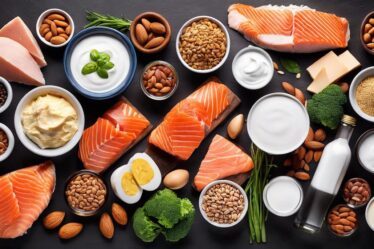
Fried eggs are a versatile and delicious addition to any meal. Whether you’re looking for a quick and easy breakfast option, a protein-packed lunch, or a satisfying dinner, fried eggs can be incorporated into a wide variety of dishes. Not only are they tasty, but they also offer several health benefits. In this article, we will explore the versatility of fried eggs, their nutritional value, and provide tips and recipes for cooking them to perfection.
Key Takeaways
- Fried eggs are versatile and can be enjoyed at any meal.
- Eating fried eggs can provide health benefits such as protein and essential vitamins.
- Perfectly frying an egg involves using low heat and a non-stick pan.
- Fried eggs can be served in a variety of ways, such as on toast or with vegetables.
- Fried eggs make for a protein-packed breakfast or quick and easy meal option.
The Versatility of Fried Eggs: Perfect for Any Meal
One of the great things about fried eggs is that they can be enjoyed at any time of day. They are a staple in breakfast dishes, such as the classic bacon and eggs or the popular egg sandwich. But they can also be incorporated into lunch and dinner options. For example, a fried egg can be placed on top of a burger or sandwich to add an extra layer of flavor and richness. It can also be used as a topping for salads or mixed into pasta dishes.
There are also several popular dishes that feature fried eggs as the star ingredient. One such dish is the traditional English breakfast, which includes fried eggs, bacon, sausage, baked beans, grilled tomatoes, and toast. Another popular dish is huevos rancheros, a Mexican breakfast dish that consists of fried eggs served on top of tortillas and smothered in salsa. Fried eggs can also be used to make delicious egg fried rice or added to stir-fries for added protein and flavor.
The Health Benefits of Eating Fried Eggs
Fried eggs are not only delicious but also offer several health benefits. They are an excellent source of high-quality protein, which is essential for building and repairing tissues in the body. Protein also helps to keep you feeling full and satisfied, making fried eggs a great option for those looking to manage their weight.
In addition to protein, fried eggs are also rich in vitamins and minerals. They are a good source of vitamin B12, which is important for maintaining healthy nerve cells and red blood cells. They also contain vitamin D, which is necessary for the absorption of calcium and the maintenance of strong bones. Fried eggs also provide important minerals such as iron, zinc, and selenium.
How to Perfectly Fry an Egg Every Time
| Step | Description |
|---|---|
| 1 | Heat a non-stick pan over medium heat for 2-3 minutes. |
| 2 | Add a small amount of butter or oil to the pan and let it melt. |
| 3 | Crack the egg into a small bowl or ramekin. |
| 4 | Gently pour the egg into the pan. |
| 5 | Cook the egg for 2-3 minutes or until the white is set and the yolk is still runny. |
| 6 | Use a spatula to carefully remove the egg from the pan. |
| 7 | Season with salt and pepper to taste. |
Frying an egg may seem like a simple task, but achieving the perfect texture and flavor can take some practice. Here is a step-by-step guide to frying an egg:
1. Heat a non-stick skillet over medium heat and add a small amount of butter or oil.
2. Crack the egg into a small bowl or ramekin to ensure that no shell gets into the pan.
3. Carefully slide the egg into the skillet, being careful not to break the yolk.
4. Cook the egg for about 2-3 minutes, until the whites are set but the yolk is still runny.
5. If you prefer a fully cooked yolk, flip the egg gently and cook for an additional 1-2 minutes.
6. Season with salt and pepper to taste.
To achieve the perfect texture, it’s important to cook the egg over medium heat. Cooking it too quickly over high heat can result in rubbery whites and overcooked yolks. It’s also important to use a non-stick skillet to prevent the egg from sticking to the pan.
The Best Ways to Serve Fried Eggs
Fried eggs can be served in a variety of ways, depending on your preferences and the dish you are preparing. Here are some serving options:
1. On toast: Place a fried egg on top of a slice of toast for a simple and satisfying breakfast or snack.
2. With vegetables: Serve fried eggs alongside sautéed vegetables for a nutritious and filling meal.
3. In a sandwich: Add a fried egg to a sandwich for an extra layer of flavor and richness.
4. On top of rice or noodles: Place a fried egg on top of a bowl of rice or noodles for added protein and flavor.
5. In a salad: Top a salad with a fried egg for a protein-packed and satisfying meal.
When serving fried eggs, it’s important to season them with salt and pepper to enhance their flavor. You can also experiment with different herbs and spices to add extra depth and complexity to the dish.
Fried Eggs as a Protein-Packed Breakfast Option

Protein is an important nutrient, especially in the morning when your body needs fuel to start the day. Fried eggs are an excellent source of high-quality protein, providing all the essential amino acids that your body needs. They are also low in carbohydrates, making them a great option for those following a low-carb or ketogenic diet.
Eating a protein-rich breakfast can help to keep you feeling full and satisfied throughout the morning, reducing the likelihood of snacking on unhealthy foods later in the day. It can also help to stabilize blood sugar levels and improve cognitive function.
To make your breakfast even more nutritious, you can pair your fried eggs with other healthy ingredients such as whole grain toast, avocado, or sautéed vegetables. This will provide you with a well-rounded meal that includes carbohydrates, healthy fats, and fiber.
Fried Eggs as a Quick and Easy Meal Solution
One of the great things about fried eggs is that they can be prepared quickly and easily, making them a perfect option for busy individuals or those who don’t enjoy spending too much time in the kitchen. All you need is a non-stick skillet, some butter or oil, and a few minutes of your time.
Fried eggs can be enjoyed on their own or incorporated into simple dishes for a complete meal. For example, you can serve them alongside some sautéed vegetables or on top of a bed of rice or noodles. You can also use them as a filling for sandwiches or wraps.
If you’re looking for a quick and easy dinner option, you can make a simple fried egg and vegetable stir-fry. Just sauté your favorite vegetables in a skillet, add some cooked rice or noodles, and top it off with a fried egg. This dish is not only delicious but also packed with nutrients.
How to Pair Fried Eggs with Other Ingredients for a Delicious Meal
Fried eggs can be paired with a wide variety of ingredients to create delicious and satisfying meals. The key is to choose ingredients that complement the flavor and texture of the eggs. Here are some suggestions:
1. Avocado: The creamy texture of avocado pairs perfectly with the rich and runny yolk of a fried egg. You can serve them together on toast or in a breakfast bowl.
2. Bacon: The salty and smoky flavor of bacon adds depth and richness to fried eggs. Serve them together for a classic breakfast combination.
3. Cheese: Melt some cheese on top of a fried egg for an extra layer of flavor and creaminess. Cheddar, feta, and goat cheese are all great options.
4. Salsa: Top your fried eggs with salsa for a spicy and tangy kick. This combination works particularly well in Mexican-inspired dishes such as huevos rancheros.
5. Spinach: Sautéed spinach adds freshness and nutrition to fried eggs. Serve them together for a healthy and satisfying meal.
When pairing ingredients with fried eggs, it’s important to consider their flavors, textures, and nutritional profiles. Experiment with different combinations to find your favorite flavor combinations.
The History and Cultural Significance of Fried Eggs
Fried eggs have been enjoyed by people around the world for centuries. While it’s difficult to pinpoint the exact origin of fried eggs, they have been a part of human diets for thousands of years. The ancient Romans and Greeks are known to have enjoyed fried eggs, and they were also a staple in medieval European cuisine.
Fried eggs have also played a significant role in different cultures and cuisines. In many Asian countries, fried eggs are commonly served with rice or noodles as a quick and easy meal option. In the Middle East, they are often served with flatbread and a variety of dips and spreads. In Mexico, fried eggs are a key ingredient in dishes such as huevos rancheros and chilaquiles.
In addition to their cultural significance, fried eggs have also been associated with various symbolic meanings. In many cultures, eggs are seen as a symbol of fertility and rebirth. They are often included in traditional celebrations and rituals.
Tips for Cooking Fried Eggs for Different Tastes and Preferences
Fried eggs can be cooked to different levels of doneness, depending on your personal preferences. Here are some tips for cooking fried eggs to different levels of doneness:
1. Sunny-side up: For a sunny-side up egg, cook the egg until the whites are set but the yolk is still runny. This is the most common way to cook fried eggs and is perfect for dipping toast or bread into the runny yolk.
2. Over easy: To cook an over-easy egg, flip the egg gently after the whites have set and cook for an additional 1-2 minutes. This will result in a slightly runny yolk that is perfect for topping burgers or sandwiches.
3. Over medium: For an over-medium egg, cook the egg until the whites are set and the yolk is partially cooked but still slightly runny. This is a great option if you prefer a slightly firmer yolk.
4. Over hard: To cook an over-hard egg, flip the egg gently after the whites have set and cook for an additional 2-3 minutes, until the yolk is fully cooked. This is a good option if you prefer a fully cooked yolk.
It’s important to note that cooking times may vary depending on the size of the egg and the heat of your stove. It may take some practice to achieve the perfect level of doneness, so don’t be discouraged if your first few attempts are not perfect.
The Many Variations of Fried Eggs from Around the World
Fried eggs are enjoyed in different variations around the world, each with its own unique flavors and ingredients. Here are some examples of unique dishes that use fried eggs:
1. Shakshuka: This Middle Eastern dish consists of fried eggs cooked in a spicy tomato sauce with onions, peppers, and spices. It is typically served with flatbread for dipping.
2. Okonomiyaki: This Japanese savory pancake is made with a batter of cabbage, flour, and eggs. It is topped with a variety of ingredients such as bacon, seafood, and vegetables, and finished with a fried egg on top.
3. Full English breakfast: This traditional English breakfast includes fried eggs, bacon, sausage, baked beans, grilled tomatoes, mushrooms, and toast. It is a hearty and satisfying meal that is typically enjoyed on weekends or special occasions.
4. Egg foo young: This Chinese dish consists of a fluffy omelet filled with vegetables such as bean sprouts, mushrooms, and onions. It is typically served with a savory gravy and rice.
These are just a few examples of the many variations of fried eggs from around the world. Each culture has its own unique way of preparing and serving fried eggs, resulting in a wide variety of delicious dishes.
Fried eggs are a versatile and delicious addition to any meal. They can be enjoyed at any time of day and can be incorporated into a wide variety of dishes. Not only are they tasty, but they also offer several health benefits. They are an excellent source of high-quality protein and provide important vitamins and minerals.
Whether you’re looking for a quick and easy breakfast option, a protein-packed lunch, or a satisfying dinner, fried eggs can be the perfect solution. They can be cooked to different levels of doneness to suit your personal preferences and can be paired with a wide variety of ingredients for a delicious and nutritious meal.
So why not try something new and incorporate fried eggs into your next meal? Whether you choose to enjoy them on their own or in a more complex dish, you’re sure to love the versatility and flavor that fried eggs bring to the table.
If you’re a fan of fried eggs, you might be interested in exploring the diverse world of culinary delights. One such article that caught my attention is “Mangosteen Mania: A Fruitful Dive” from Flavorful Sips. This fascinating piece delves into the exotic and delicious mangosteen fruit, highlighting its unique flavor profile and health benefits. So, why not take a break from your usual breakfast routine and discover the wonders of mangosteen? Check out the article here and embark on a flavorful journey!



